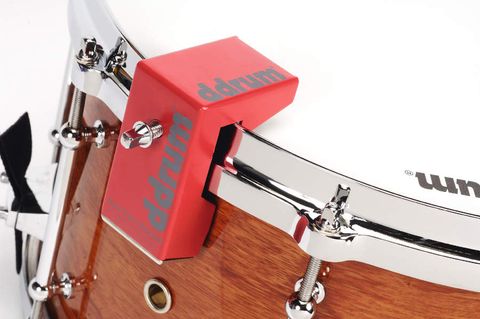American-owned ddrum made its name in electronic percussion (both kits and triggers). For those with even a passing knowledge of converting a drum head´s acoustic energy into an electronic signal, ddrum´s reputation in the field is a given. ddrum triggers have graced more pro kits, on international stages and in the world´s finest recording facilities, than any other trigger device.
Users include an array of stars from all genres, from Helmet´s John Tempesta to Prince´s John Blackwell - no matter what you play or what sounds you want to trigger, ddrum stuff has become de rigeur for thousands of pros and serious amateurs over the years. Which is why it´s a little disconcerting, on your first encounter with the Pro triggers, to find that they´re so unprepossessing in terms of the way they´re constructed. For units that provide the link between acoustic drums and sound modules in high pressure situations, they´re remarkably simple.
Simple But Effective
There´s an even more stripped-down offering from ddrum (the Red Shot range), but even the Acoustic Pros dispense with any unnecessary constructional niceties. Each of the units in the box set here (which ships with three tom, one snare and one kick drum triggers) is built into a straightforward bent steel chassis, adorned with simple grey ddrum logo. Any simpler, or less well-made, and they´d look almost agricultural. The tom and snare triggers are exactly the same in terms of build.
There´s a notch cut into the shorter part of the ‘L´-shaped bracket for clipping over the drum hoop, and a drum-key tensionable rod that holds the unit in place. It´s a 30-second procedure to throw a trigger on a drum and get it secured.
"The XLR connector affords a real sense of roadworthy reliability, and the fact that the triggers are a plug-and-play option with pretty much any drum module means there´s no faffing from that point of view either".
Perhaps the only upgrade to this arrangement would be some kind of protective strip on the section that butts up against the drum shell itself. I can´t see vintage drum owners risking the triggers marking their precious shells - but then again, do vintage kit lovers use triggers? It´s a moot point.
The only point of difference between snare and tom triggers is that the snare type also features a transducer mounted on the inside of the clamp, which brings it into contact with the rim of the drum, thus allowing separate triggering signals from head and rim.
The kick drum trigger works in similar fashion to the tom units, but this time the clamping action involves a plate (to which the trigger pad itself is fixed) that allows a little movement to suit the various size of kick drum hoops to which it might find itself attached.
Here as well is a thick rubber pad on the underside of the main section to ensure the trigger doesn´t move about during use.
All On Show
The electrical trickery within the triggers is as uncomplicated as the rest of the devices. The sensors that rest against the heads are encased in a square of blue foam and these are connected to XLR jacks by wiring that´s in clear view. Wires are just about kept out of harm´s way by cable routers or plastic sleeving, but again the Heath Robinson effect is to the fore.
But really, given that ddrum triggers have been proven to work in the toughest situations over decades, who should worry? The design just works, and with minimal interference to the shells and the way you play. The triggers don´t have to be fixed to the drums so hard that they interfere with the response of the head and they demonstrate excellent responsiveness, with a dynamic range that takes softly softly ghost strokes and cracking backbeats in its stride.
The XLR connector affords a real sense of roadworthy reliability (and is certainly a preferred option over the jack output of the cheaper Red Dots), and the fact that the triggers are a plug-and-play option with pretty much any drum module means there´s no faffing from that point of view either. ddrum also reckons that this latest showing offers a stronger signal output (up to 20 percent) than previous incarnations.
Despite not having earlier versions to hand during the review period, we can say that, just as expected, these little red gems performed flawlessly throughout.

